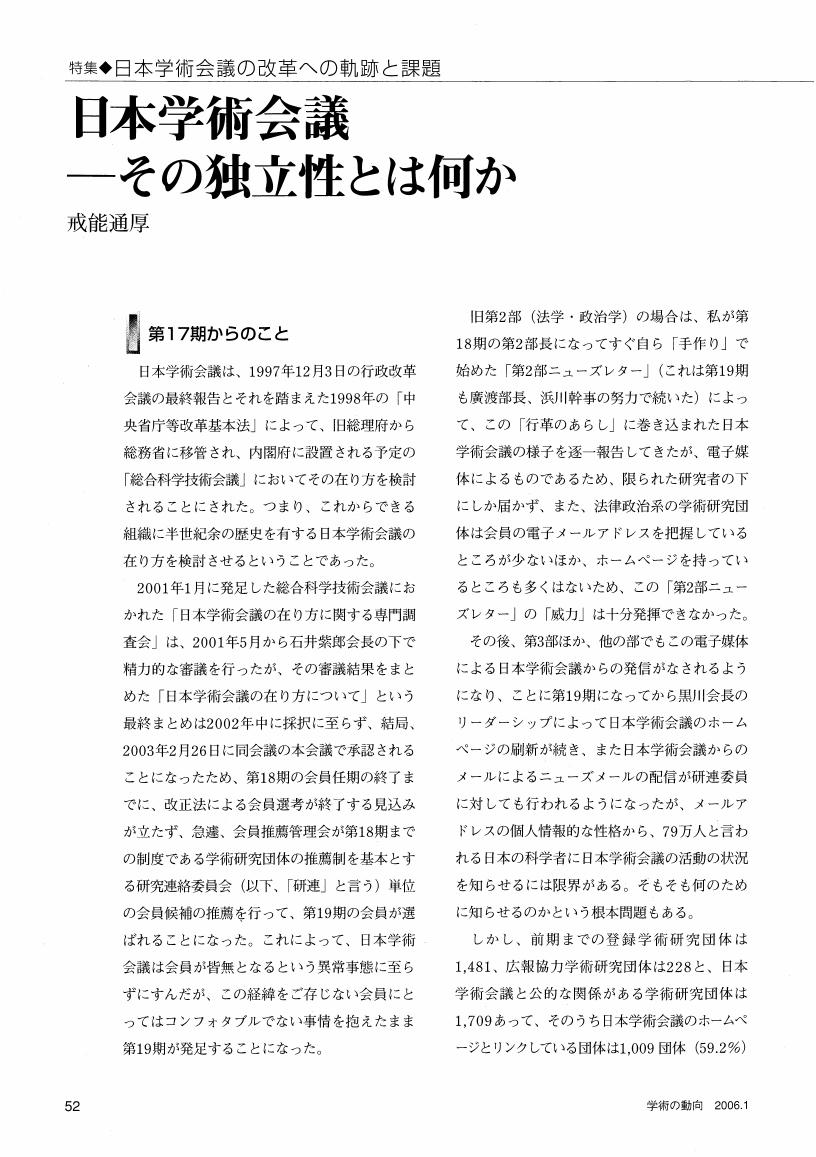14 0 0 0 OA 日本学術会議-その独立性とは何か
- 著者
- 戒能 通厚
- 出版者
- 公益財団法人 日本学術協力財団
- 雑誌
- 学術の動向 (ISSN:13423363)
- 巻号頁・発行日
- vol.11, no.1, pp.52-59, 2006-01-01 (Released:2009-12-21)
- 参考文献数
- 9
3 0 0 0 日本学術会議-その独立性とは何か
- 著者
- 戒能 通厚
- 出版者
- 公益財団法人 日本学術協力財団
- 雑誌
- 学術の動向 (ISSN:13423363)
- 巻号頁・発行日
- vol.11, no.1, pp.52-59, 2006
2 0 0 0 OA 論説: 「採光権」についての一考察
- 著者
- 戒能 通厚
- 出版者
- 早稲田大学比較法研究所
- 雑誌
- 比較法学 (ISSN:04408055)
- 巻号頁・発行日
- vol.51, no.1, pp.1-27, 2017-06-01
1 0 0 0 現代イギリス法事典
- 著者
- 戒能通厚編
- 出版者
- サイエンス社 (発売)
- 巻号頁・発行日
- 2003
1 0 0 0 OA イギリス近代法の多元的構造—法の歴史的分析・再考—
- 著者
- 戒能 通厚
- 出版者
- 日本法哲学会
- 雑誌
- 法哲学年報 (ISSN:03872890)
- 巻号頁・発行日
- vol.1988, pp.79-94, 1989-10-30 (Released:2008-11-17)
- 参考文献数
- 23
1 0 0 0 OA 法曹一元論の原点
- 著者
- 戒能 通厚
- 出版者
- 日本法社会学会/有斐閣
- 雑誌
- 法社会学 (ISSN:04376161)
- 巻号頁・発行日
- vol.2000, no.53, pp.29-45,245, 2000-12-20 (Released:2009-01-15)
- 参考文献数
- 16
Legal Profession of Japan was created after the Meiji Restoration. Since the government did not intend to develop a strong private bar that could represent citizens in disputes, the primary objective of securing the law graduates through hard exam. for the government was to produce judges, prosecutors and upper-level state bureaucrats. After the World War II, the Practicing Attorneys Act was revised to put practicing lawyers on equal footing with prosecutors and judges. Since then, members of all three groups follow a similar path. However, the route to judgeship in Japan starts with a kind of apprenticeship as an assistant judge followed by the promotion system in the Japanese court hierarchies as 'independent and full time judge', Although law is a popular undergraduate major in Japan, a degree from law department is not prerequisite to sitting for the National Bar Exam. which is said to be the most difficult exam. in Japan.Last year, the government had appointed the Judicial Reform Committee chaired by Prof. Koji Sato of Kyoto University and the Committee is now preparing Interim Report mainly focusing on the increase of the number of Bengoshi (attorney at law) as well as reform of Bengoshi-system for much easier access to Bengoshi.Some bengoshi groups are now promoting Hoso-Ichigen (Anglo-American System of the judicial appointments) which is simply to limit the resource of judge to practicing bar (or prosecutors) in order to abolish bureaucratic judgeship ruled by the General Secretariat to the Supreme Court.This article is discussing the historical origin of the notion of Hoso-Ichigen as well as the independence of Bengoshi and also criticizing the introduction of Japanese version of Law School system into universities without any prospect of the realization of Judicial Reform in Japan.


